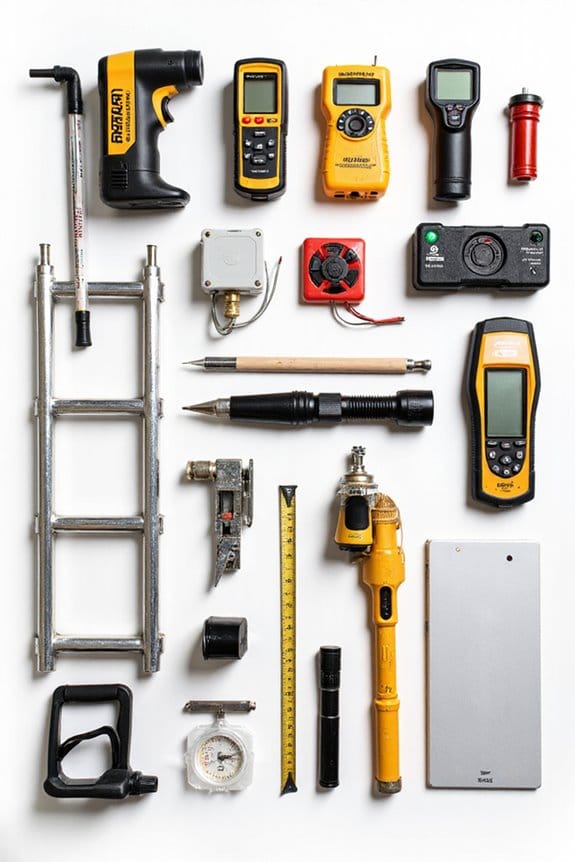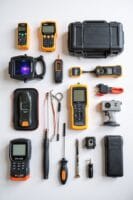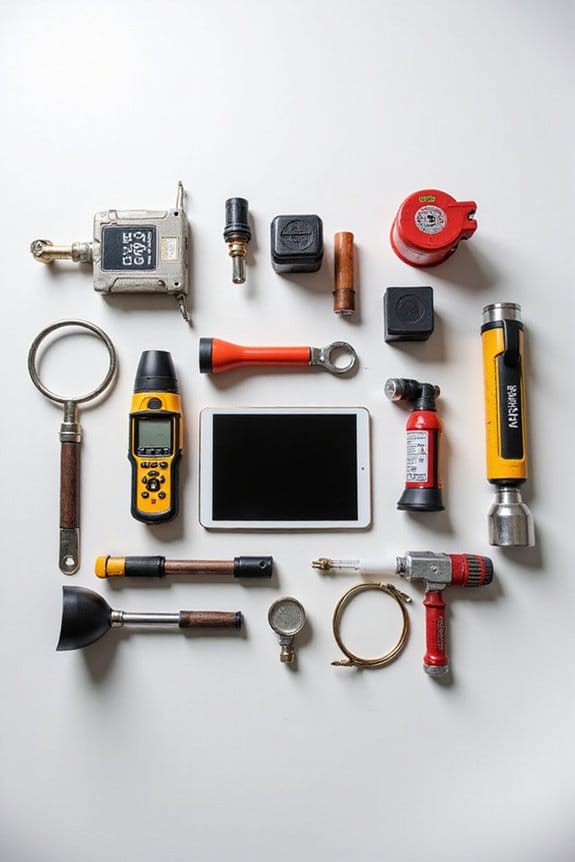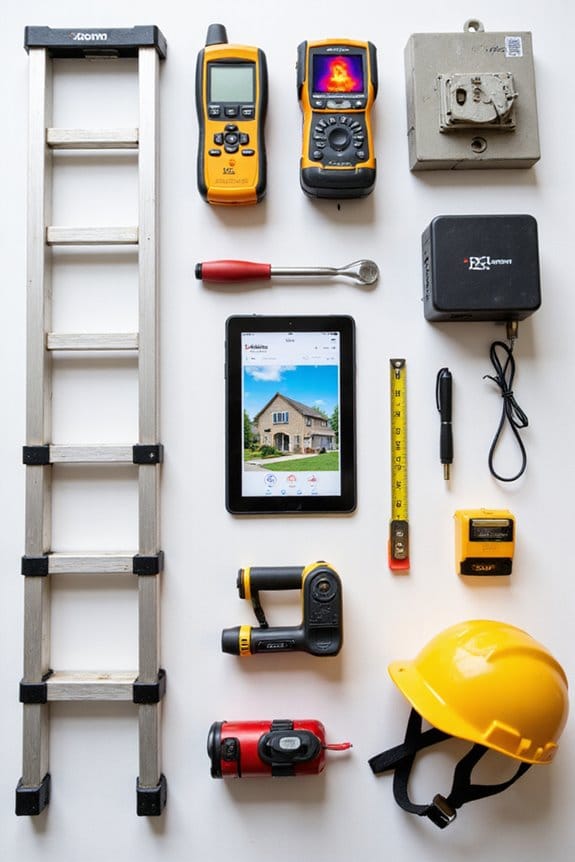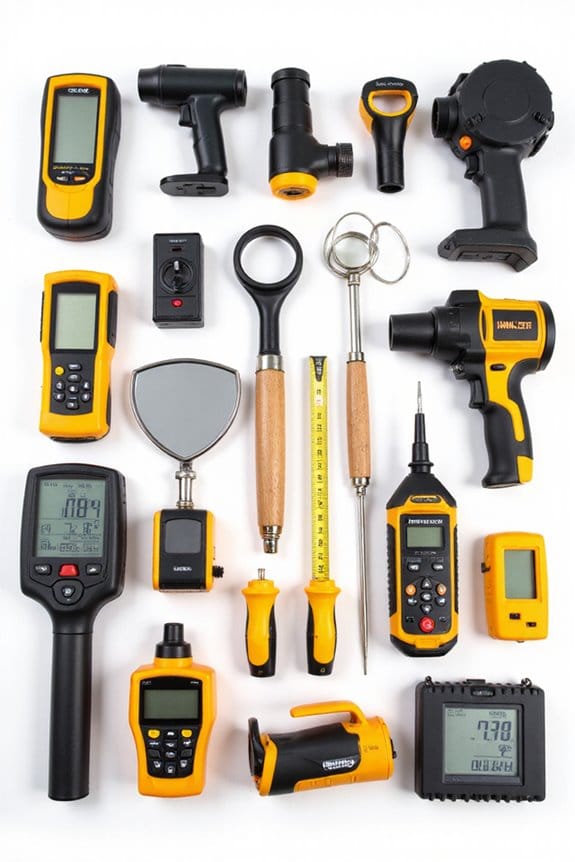When I look at inspection reports, I always watch for red flags. Here’s what I find critical: 1) Structural issues like foundation cracks; 2) Water damage, often hiding under new paint; 3) Electrical problems, such as old wiring; 4) HVAC concerns with strange noises; 5) Pest infestations, seen in droppings; and 6) Roof and deck hazards. Spotting these early can save money and stress later! Stick around, and I’ll share more helpful insights.
Key Takeaways
- Foundation cracks, especially horizontal ones, indicate potential structural failures that need urgent attention.
- Water stains and musty odors suggest underlying moisture problems that could lead to mold growth.
- Old wiring and frequent breaker trips are red flags for electrical hazards and safety risks.
- Unusual HVAC noises and odors may signal mechanical issues requiring immediate repair.
- Signs of pest infestations, such as droppings and gnaw marks, indicate potential property damage.
Structural Issues
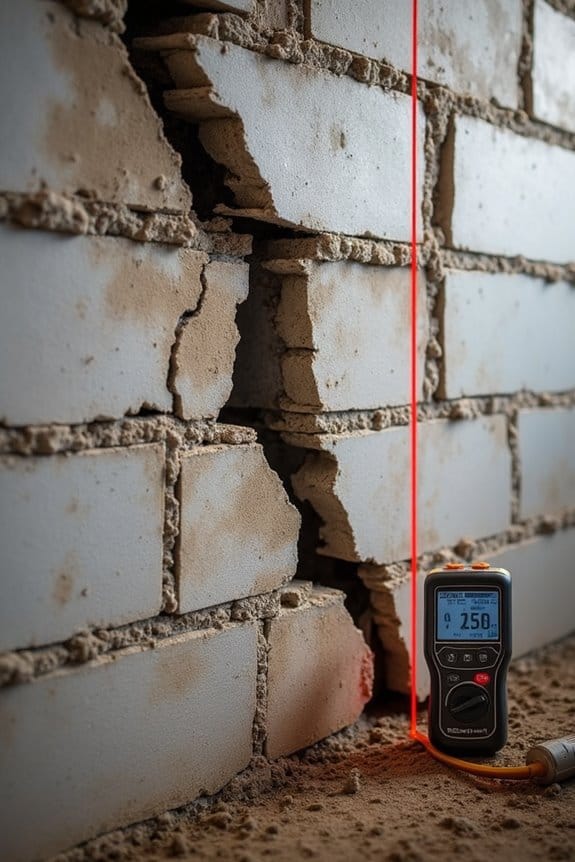
When it comes to structural issues in a home, I can’t stress enough the importance of paying attention to the details. Here are some red flags to watch out for:
- Foundation Cracks: Horizontal cracks in your foundation walls can indicate serious structural failure risks. If you see these, don’t ignore them!
- Uneven Floors: If your floors are sloping or uneven, it might suggest foundation settling or shifting.
- Framing Defects: Look for improperly cut rafters or sagging joists. These can compromise your home’s integrity.
- Gaps and Separation: Noticeable gaps between walls and floors or ceilings can signal movement.
Addressing these issues early can save you from costly repairs down the line. It’s like catching a cold before it turns into pneumonia—better safe than sorry!
Water and Moisture Problems

Here is the revised content with the new sentence added:
—
Structural issues aren’t the only concerns when it comes to a home inspection; water and moisture problems can be just as sneaky and harmful. Here are a few red flags to watch for:
- Water stains: Fresh paint or new carpets might hide past leaks. Don’t ignore signs!
- Musty odors: If it smells damp, there’s likely moisture lurking somewhere.
- Visible mold: Especially in kitchens and bathrooms, it’s a clear sign of persistent moisture issues.
- Warped wood: Buckling baseboards or beams can indicate water damage.
Keeping an eye on these issues is key to effective moisture control. If you spot any of these red flags, it’s time to dig deeper and address potential water intrusion before it becomes a bigger problem! Additionally, consider using a moisture meter to accurately assess moisture levels in various materials, helping to prevent further damage.
Electrical System Concerns
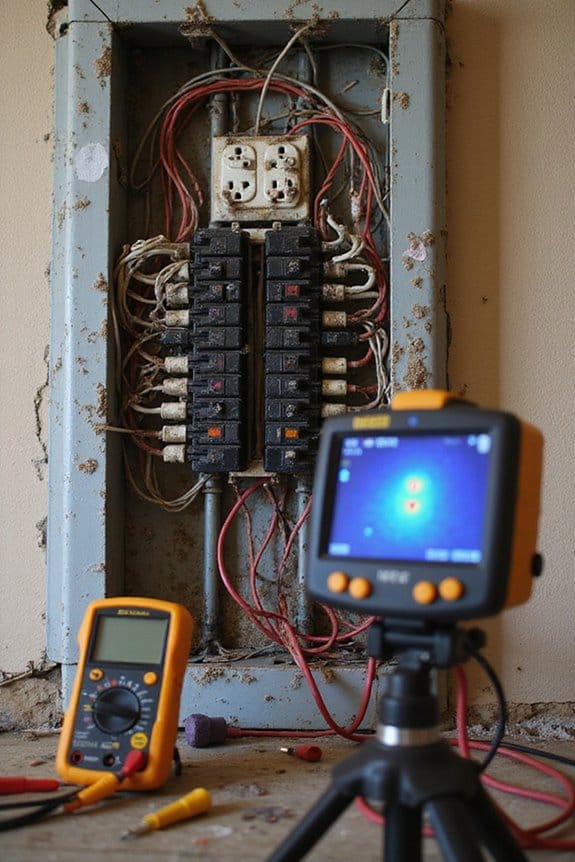
Electrical systems are often overlooked, but they can be just as critical to your home’s safety and functionality. Here are some red flags to watch for:
- Frequent Breaker Trips: This often indicates circuit overloads, meaning your circuits are overworked or faulty.
- Old Wiring: Knob-and-tube wiring or aluminum wiring can pose significant wiring hazards, particularly in homes built between 1965-1973.
- Scorch Marks: These signs of overheating on wires or panels can be alarming and often point to serious issues.
- Loose Connections: If you hear buzzing or crackling sounds, it could mean loose wires, increasing fire risks.
Always prioritize inspecting your electrical system. It’s better to tackle these problems early than to face potential disasters later!
HVAC and Mechanical Systems
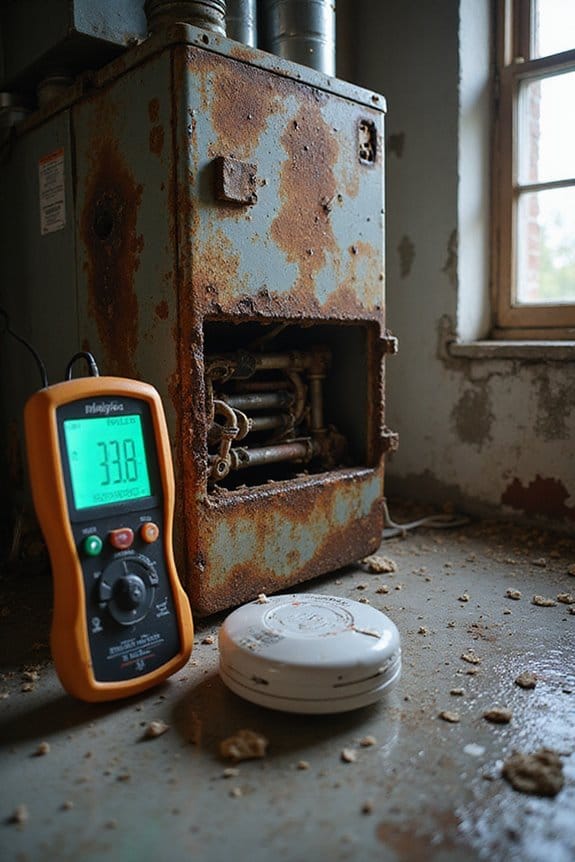
Although many homeowners focus on aesthetics and structural integrity, I believe it’s just as important to pay attention to your HVAC and mechanical systems. Here are some red flags to watch for:
- Unusual Noises: Banging or grinding sounds can mean components are worn out.
- Strange Odors: Burning smells or musty odors signal bigger issues, like mold.
- Indoor Air Quality: If you’re sneezing a lot, it could be dirty filters or ducts.
- Uneven Heating/Cooling: Some rooms too hot or cold? Check your thermostat!
- Frequent Breakdowns: If it keeps failing, something’s definitely off.
Keeping an eye on these aspects can boost HVAC efficiency and improve your indoor air quality. After all, who wants to breathe in dust and mold? Additionally, regular maintenance practices, such as cleaning condensate traps, can help prevent many of these issues from arising in the first place.
Health and Safety Hazards

When you think about keeping your home safe, it’s easy to overlook the health and safety hazards lurking in plain sight. Here are a few to take into account:
- Chemical Exposure: Hazardous substances like benzene and lead can be found in various products. Proper storage and use are essential to prevent accidents.
- Electrical Safety: Faulty wiring is a common issue. Make sure that everything is installed by a qualified electrician and regularly inspected, as non-contact voltage detection can help identify live wires safely during inspections.
- Ergonomic Risks: An unsafe workplace layout can lead to injuries. Keep pathways clear and design workstations to prevent strain.
Maintenance and Cosmetic Issues With Impact
Maintaining a home isn’t just about keeping things looking good; it’s also essential for ensuring everything runs smoothly and safely. Here are some major maintenance and cosmetic issues that can have a significant impact:
- Wood Rot: This can compromise your structure, so keep an eye on windows and doors.
- Cracked Foundations: These may signal bigger problems lurking below.
- Poor Grading: It can lead to flooding and water damage—yikes!
- Corroded Fixtures: Rusty plumbing components can cause leaks.
Consider investing in high-quality tools, like an adjustable wrench, to help you tackle minor repairs before they escalate. Don’t forget to stick to your maintenance schedules to avoid costly repairs. And while you’re at it, consider those cosmetic upgrades that not only enhance aesthetics but can also help with maintenance, like sealing windows or updating fixtures. Trust me; a little effort now saves a lot later!
Signs of Pest Infestations
Taking care of your home goes beyond just maintenance and cosmetic upgrades; it also means keeping an eye out for pesky critters that might be trying to invade your space. Here are some signs of pest infestations to watch for:
- Droppings: Look for small pellets; they can help with pest identification techniques.
- Gnaw Marks: Noticeable on wood or food packaging? That’s a rodent alert!
- Nests: Shredded materials in hidden places could mean pests are nesting.
- Tracks: Greasy smudges on walls show frequent pest travel routes.
- Structural Damage: Wood shavings? Termites might be at work.
Utilizing effective infestation prevention strategies can save you from future headaches. Always stay vigilant!
Roof Problems
Roof problems can sneak up on even the most vigilant homeowners, often leading to costly repairs if not addressed promptly. Here are some key issues to watch for:
- Missing or Damaged Shingles: These can indicate potential leaks and lead to roof deterioration.
- Flashing Failures: Look for corrosion or gaps around vents and chimneys; they often signal water intrusion.
- Ponding Water: On flat roofs, it can cause membrane breakdown.
- Deteriorated Underlayment: This compromises waterproofing and can lead to leaks.
- Blocked Gutters: Poor drainage systems make water accumulation worse.
Keeping an eye on these red flags can save you a lot of trouble down the road. Trust me; your wallet will thank you!
Deck and Patio Safety Issues
While enjoying your deck or patio can be a great way to relax, it’s crucial to keep safety in mind. Here are a few red flags to watch out for:
- Deck Stability: Check for rust on metal connectors; it can weaken the entire structure. Replace any corroded parts and inspect for hidden wood damage.
- Railing Height: Verify your railings are at least 36 inches tall. Low or loose railings can be a serious fall risk, especially for kids or pets.
- Wood Damage: Look for rot, deep cracks, or warped boards. These signs can indicate serious issues that could lead to failure.
Frequently Asked Questions
How Can I Interpret Inspection Report Findings Effectively?
When I analyze an inspection report, I focus on the terminology and findings, like “functional” or “poor.” Understanding these terms helps me interpret the data effectively, ensuring I prioritize repairs based on urgency and safety.
What Should I Prioritize When Addressing Red Flags?
When addressing red flags, I prioritize repairs that tackle serious concerns first. Safety hazards and structural defects are at the top of my list, ensuring the home’s integrity and my family’s well-being come first.
How Can Red Flags Affect Property Value?
Red flags can sink a property’s value like a stone! Deferred maintenance creates a cloud of doubt, skewing market perception. Buyers might flee, fearing hefty repair bills, leaving sellers in a tight spot. It’s essential to address them!
Are All Red Flags Deal-Breakers for Home Buyers?
Not all red flags are deal-breakers for me. My buyer mindset focuses on deal breaker criteria like severity and repair costs. I weigh each issue carefully, often finding manageable solutions through negotiation or strategic planning.
How Do I Negotiate Repairs Based on Inspection Results?
When it comes to repair negotiations after inspection results, I always emphasize critical issues. I focus on safety and major repairs, using estimates to support my requests—because who wouldn’t want a fair deal on their new home?

